Microwave Imaging of Uniaxial Objects Using a Hybrid Input U-Net
Abstract
1. Introduction
- To the best of our knowledge, there is no prior research that integrates BP and DSM as hybrid input measures within the U-Net architecture for uniaxial object imaging. The proposed method effectively leverages BP’s capability to reconstruct dielectric properties and DSM’s ability to extract spatial information, significantly improving reconstruction accuracy while maintaining minimal computational cost.
- This paper tackles the nonlinear effects and field coupling challenges in TE wave-based imaging, which are inherently more complex than in TM waves. By refining the hybrid inputs and incorporating precise incident angle adjustments, the proposed method can effectively mitigate the aforementioned issues, resulting in more stable and accurate reconstructions.
- Extensive numerical simulations demonstrate that the BP-DSM hybrid input mechanism achieves higher accuracy and an improved Structural Similarity Index Measure (SSIM) compared to the use of the BP scheme alone. Moreover, the proposed method also exhibits strong performance even under high noise conditions (e.g., 20% Gaussian noise), showcasing its robustness and applicability to real-world electromagnetic environments.
2. Formulation of the Problem
2.1. Direct Problem
2.2. Back-Propagation (BP)
2.3. Direct Sampling Methods (DSMs)
3. U-Net
4. Numerical Results
4.1. Simulation Configuration
- (1)
- 1.2–1.5, representing materials such as Teflon, PTFE, or dry wood;
- (2)
- 1.5–2.0, corresponding to acrylic, plastics, and epoxy resins;
- (3)
- 2.0–2.5, covering low-loss ceramics, glass, and dense polymer composites.
4.2. Dielectric Permittivity Between 1 and 1.5 with 20% Noise
4.3. Dielectric Permittivity Ranges from 1.5 to 2 with 5% Noise
4.4. Dielectric Permittivity Ranges Between 2 and 2.5 with 5% Noise
5. Conclusions
Author Contributions
Funding
Data Availability Statement
Conflicts of Interest
References
- Kang, S.; Lambert, M.; Ahn, C.Y.; Ha, T.; Park, W.K. Single- and Multi-Frequency Direct Sampling Methods in a Limited-Aperture Inverse Scattering Problem. IEEE Access 2020, 8, 121637–121649. [Google Scholar] [CrossRef]
- Harris, I. Direct sampling algorithms based on the factorization method for inverse scattering. In Proceedings of the 2021 IEEE Research and Applications of Photonics in Defense Conference (RAPID), Miramar Beach, FL, USA, 2–4 August 2021. [Google Scholar]
- Saraskanroud, F.M.; Jeffrey, I. Hybrid Approaches in Microwave Imaging Using Quantitative Time- and Frequency-Domain Algorithms. IEEE Trans. Comput. Imaging 2022, 8, 121–132. [Google Scholar] [CrossRef]
- Zhong, Y.; Zardi, F.; Salucci, M.; Oliveri, G.; Massa, A. Multiscaling Differential Contraction Integral Method for Inverse Scattering Problems with Inhomogeneous Media. IEEE Trans. Microw. Theory Tech. 2023, 71, 4064–4079. [Google Scholar] [CrossRef]
- Li, J.; Li, Z.; Guan, Z.; Han, F. 2-D Electromagnetic Scattering and Inverse Scattering from Anisotropic Objects Under TE Illumination Solved by the Hybrid SIM/SEM. IEEE Trans. Antennas Propag. 2024, 72, 3517–3528. [Google Scholar] [CrossRef]
- Li, L.; Wang, L.G.; Teixeira, F.L. Performance Analysis and Dynamic Evolution of Deep Convolutional Neural Network for Electromagnetic Inverse Scattering. IEEE Antennas Wirel. Propag. Lett. 2019, 18, 2259–2263. [Google Scholar] [CrossRef]
- Yao, H.M.; Jiang, L.; Sha, W.E.I. Enhanced Deep Learning Approach Based on the Deep Convolutional Encoder–Decoder Architecture for Electromagnetic Inverse Scattering Problems. IEEE Antennas Wirel. Propag. Lett. 2020, 19, 1211–1215. [Google Scholar] [CrossRef]
- Zhang, L.; Xu, K.; Song, R.; Ye, X.; Wang, G.; Chen, X. Learning-Based Quantitative Microwave Imaging with a Hybrid Input Scheme. IEEE Sens. J. 2020, 20, 15007–15013. [Google Scholar] [CrossRef]
- Li, H.; Chen, L.; Qiu, J. Convolutional Neural Networks for Multifrequency Electromagnetic Inverse Problems. IEEE Antennas Wirel. Propag. Lett. 2021, 20, 1424–1428. [Google Scholar] [CrossRef]
- Xu, K.; Zhang, C.; Ye, X.; Song, R. Fast Full-Wave Electromagnetic Inverse Scattering Based on Scalable Cascaded Convolutional Neural Networks. IEEE Trans. Geosci. Remote Sens. 2022, 60, 2001611. [Google Scholar] [CrossRef]
- Han, F.; Zhong, M.; Fei, J. Hybrid Microwave Imaging of 3-D Objects Using LSM and BIM Aided by a CNN U-Net. IEEE Trans. Geosci. Remote Sens. 2022, 60, 2006809. [Google Scholar] [CrossRef]
- Liu, C.; Zhang, H.; Li, L.; Cui, T.J. Towards Intelligent Electromagnetic Inverse Scattering Using Deep Learning Techniques and Information Meta-surfaces. IEEE J. Microwaves 2023, 3, 509–522. [Google Scholar] [CrossRef]
- Yao, H.M.; Jiang, L.; Ng, M. Enhanced Deep Learning Approach Based on the Conditional Generative Adversarial Network for Electromagnetic Inverse Scattering Problems. IEEE Trans. Antennas Propag. 2024, 72, 6133–6138. [Google Scholar] [CrossRef]
- Chiu, C.C.; Chen, P.H.; Jiang, H. Electromagnetic Imaging of Uniaxial Objects by Artificial Intelligence Technology. IEEE Trans. Geosci. Remote Sens. 2022, 60, 2008414. [Google Scholar] [CrossRef]
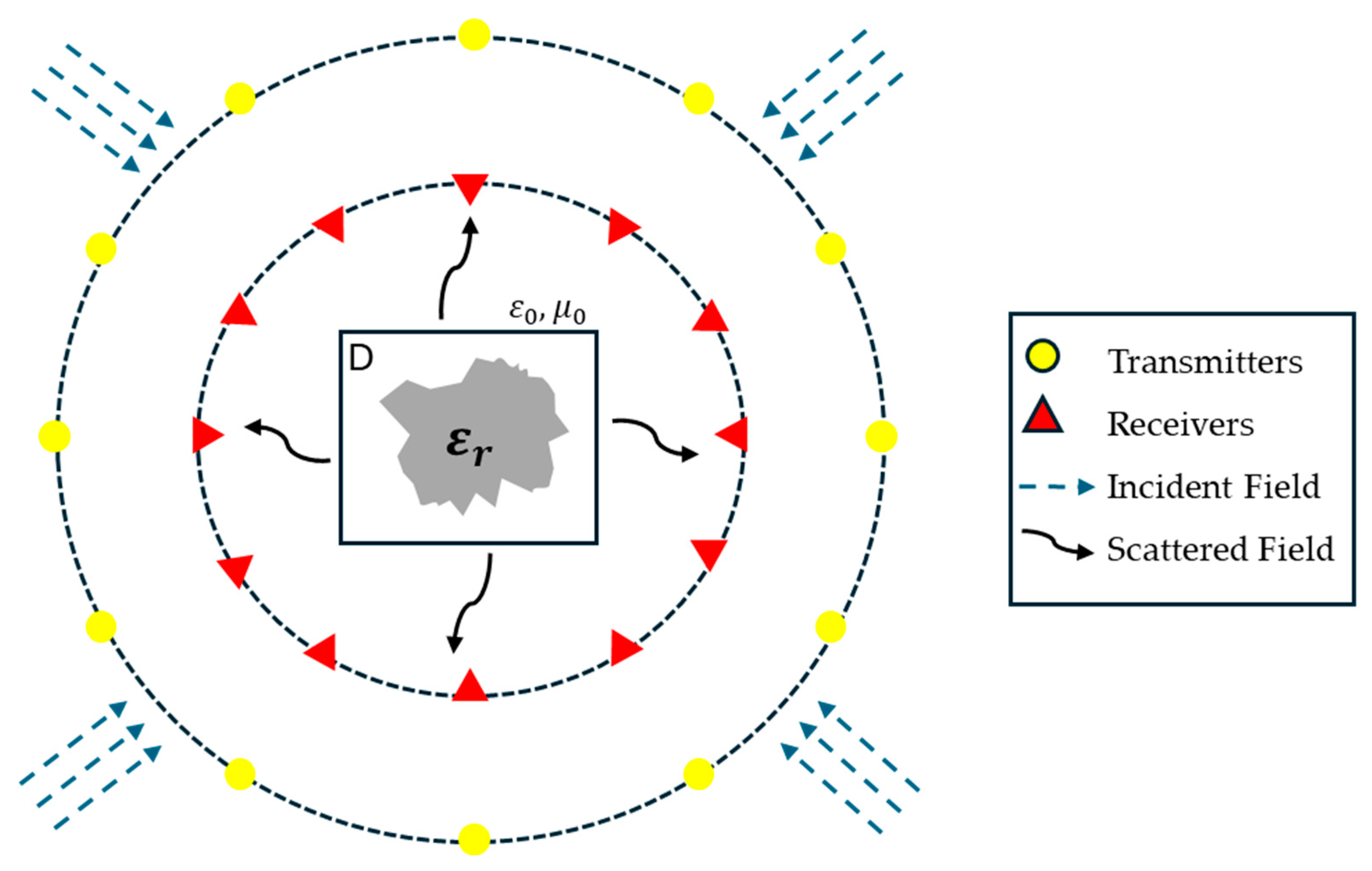


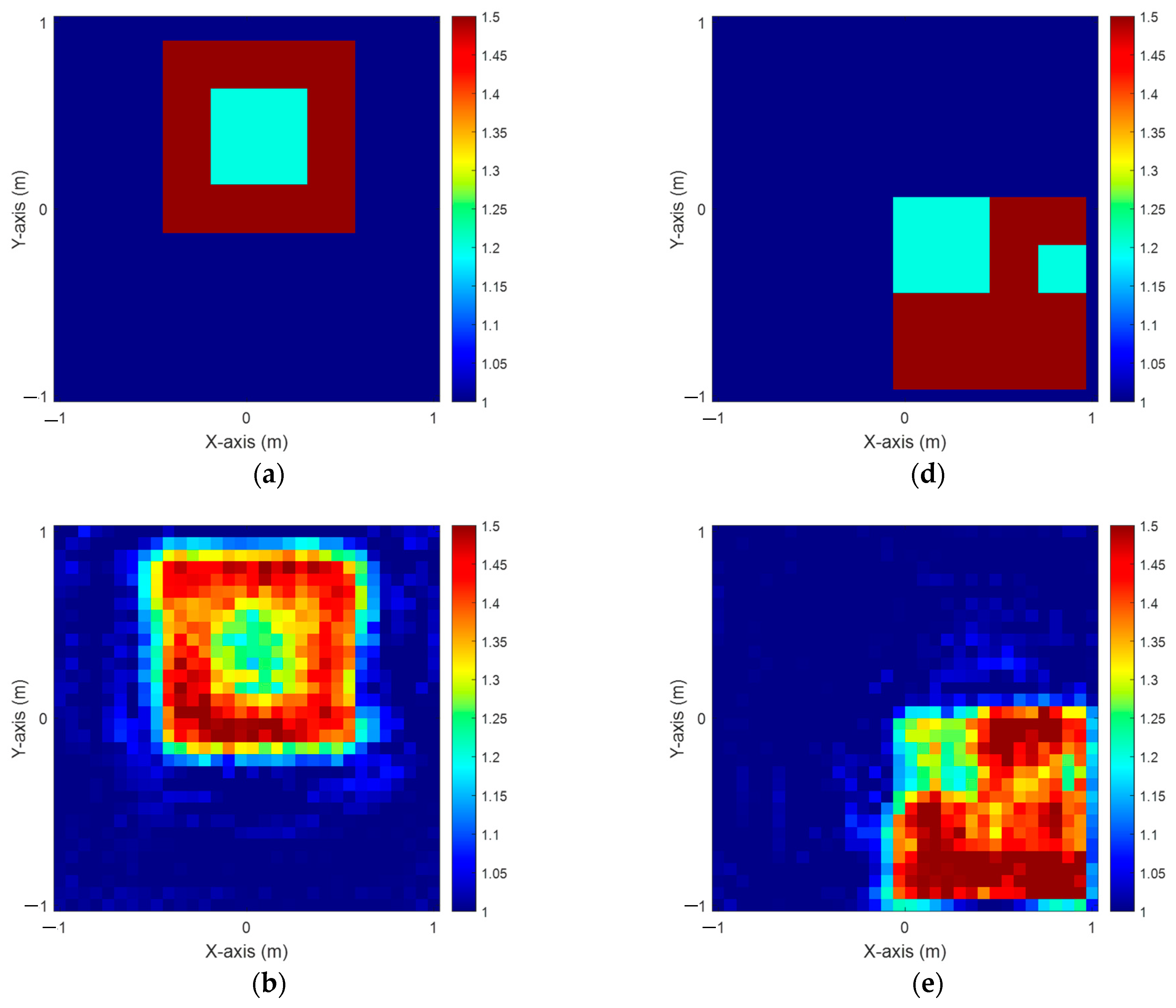
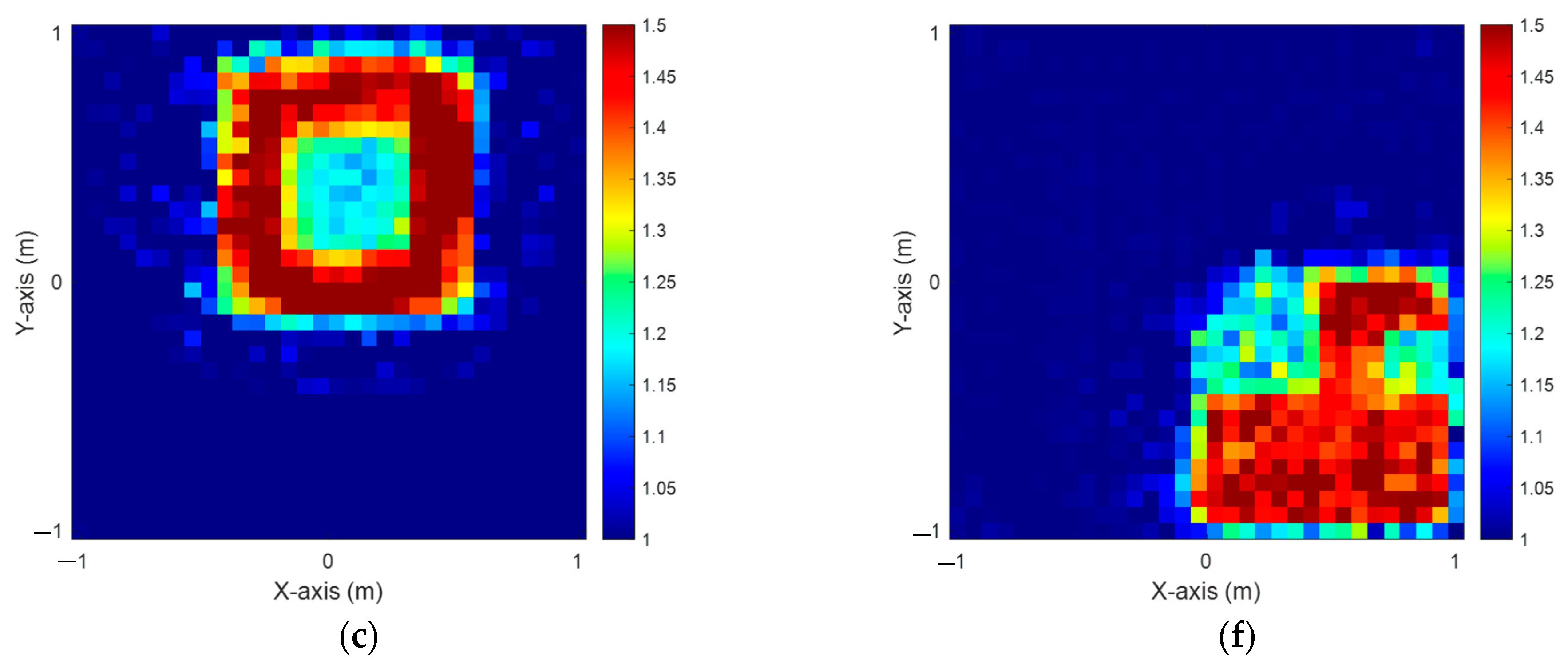
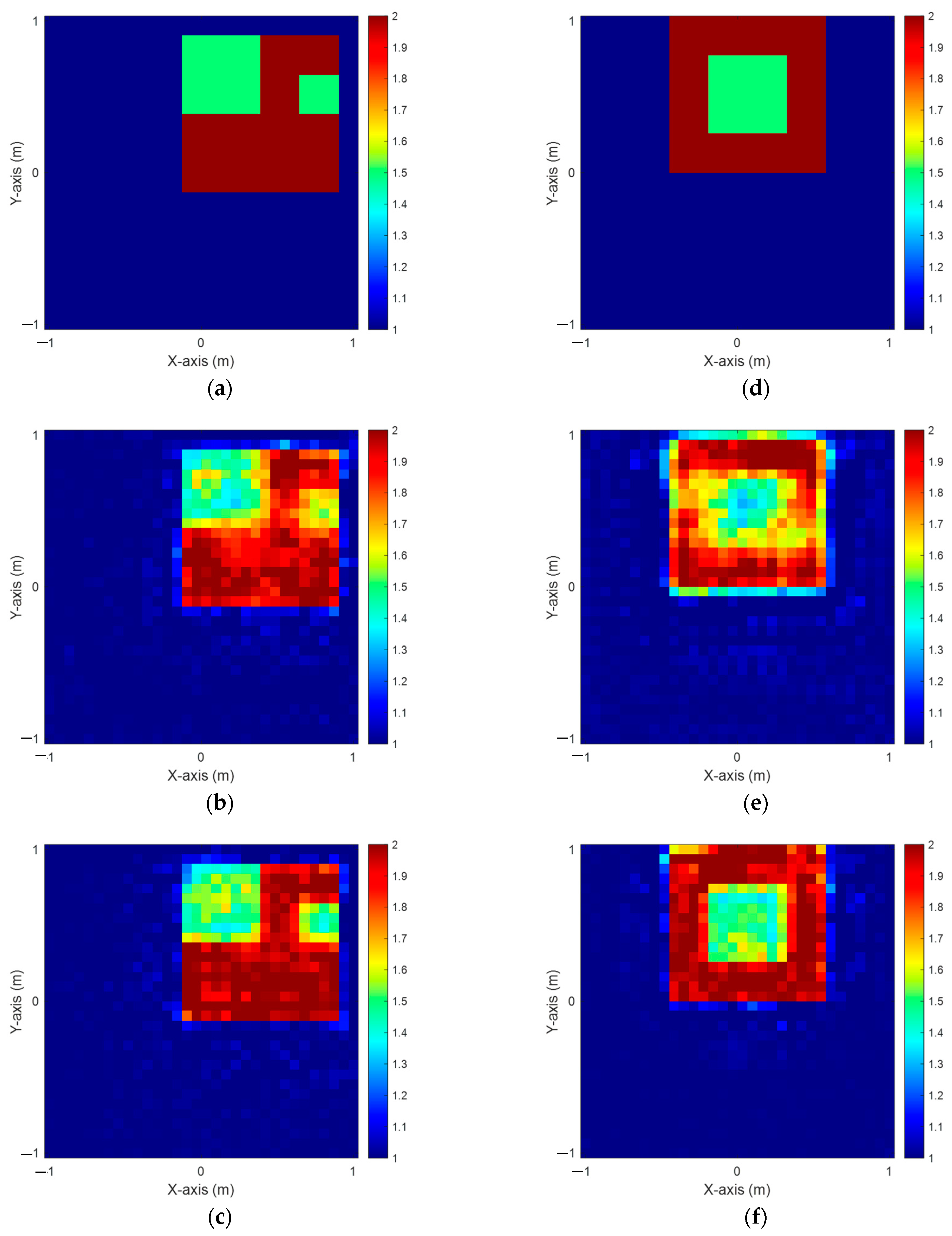
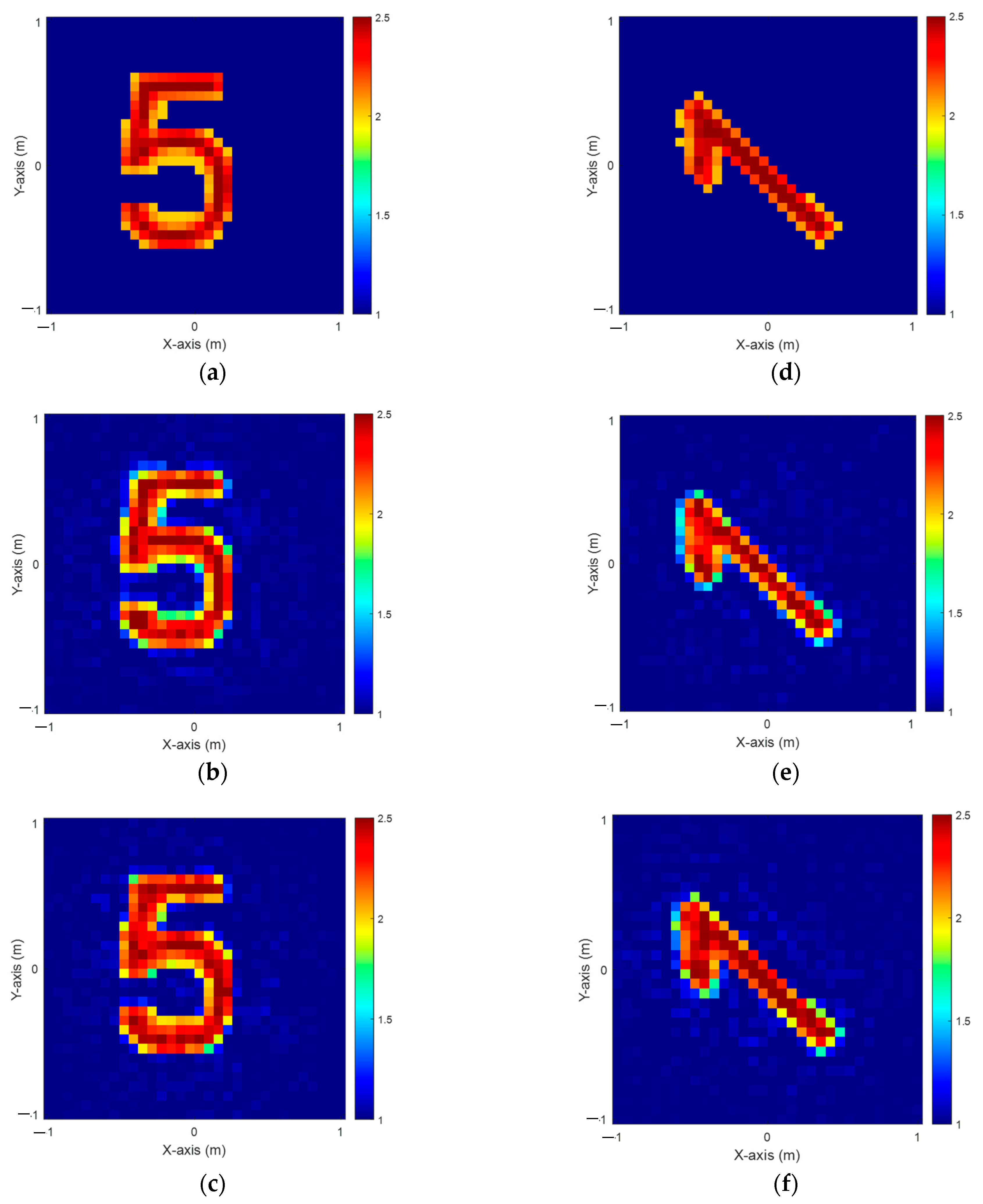
| Performance | ||||
|---|---|---|---|---|
| BP | BP-DSM | BP | BP-DSM | |
| RMSE | 7.05% | 6.38% | 5.7% | 4.71% |
| SSIM | 81.59% | 86.85% | 88.17% | 92.13% |
| Performance | ||||
|---|---|---|---|---|
| BP | BP-DSM | BP | BP-DSM | |
| RMSE | 5.7% | 4.77% | 6.54% | 4.51% |
| SSIM | 93.79% | 94.03% | 93.57% | 97.24% |
| Performance | ||||
|---|---|---|---|---|
| BP | BP-DSM | BP | BP-DSM | |
| RMSE | 8.37% | 7.77% | 7.87% | 6.51% |
| SSIM | 86.48% | 87.1% | 86.31% | 90.37% |
Disclaimer/Publisher’s Note: The statements, opinions and data contained in all publications are solely those of the individual author(s) and contributor(s) and not of MDPI and/or the editor(s). MDPI and/or the editor(s) disclaim responsibility for any injury to people or property resulting from any ideas, methods, instructions or products referred to in the content. |
© 2025 by the authors. Licensee MDPI, Basel, Switzerland. This article is an open access article distributed under the terms and conditions of the Creative Commons Attribution (CC BY) license (https://creativecommons.org/licenses/by/4.0/).
Share and Cite
Lee, W.-T.; Chiu, C.-C.; Chen, P.-H.; Cheng, H.-M.; Lim, E.H. Microwave Imaging of Uniaxial Objects Using a Hybrid Input U-Net. Electronics 2025, 14, 1633. https://doi.org/10.3390/electronics14081633
Lee W-T, Chiu C-C, Chen P-H, Cheng H-M, Lim EH. Microwave Imaging of Uniaxial Objects Using a Hybrid Input U-Net. Electronics. 2025; 14(8):1633. https://doi.org/10.3390/electronics14081633
Chicago/Turabian StyleLee, Wei-Tsong, Chien-Ching Chiu, Po-Hsiang Chen, Hung-Ming Cheng, and Eng Hock Lim. 2025. "Microwave Imaging of Uniaxial Objects Using a Hybrid Input U-Net" Electronics 14, no. 8: 1633. https://doi.org/10.3390/electronics14081633
APA StyleLee, W.-T., Chiu, C.-C., Chen, P.-H., Cheng, H.-M., & Lim, E. H. (2025). Microwave Imaging of Uniaxial Objects Using a Hybrid Input U-Net. Electronics, 14(8), 1633. https://doi.org/10.3390/electronics14081633








